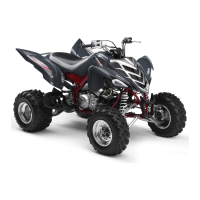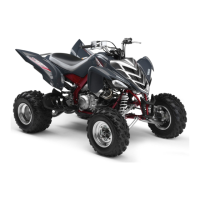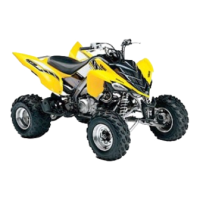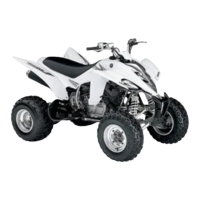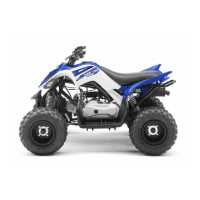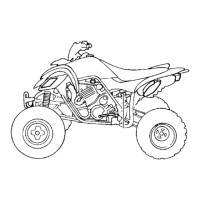ENGINE
3-10
EAS20710
MEASURING THE COMPRESSION
PRESSURE
IP
Insufficient compression pressure will result in a
loss of performance.
1. Measure:
• Valve clearance
Out of specification → Adjust.
Refer to “ADJUSTING THE VALVE CLEAR-
ANCE” on page 3-4.
2. Start the engine, warm it up for several min-
utes, and then turn it off.
3. Disconnect:
• Spark plug cap
4. Remove:
• Spark plug
NOTICE
ECA1S3L026
Before removing the spark plug, use com-
pressed air to blow away any dirt accumulat-
ed in the spark plug well to prevent it from
falling into the cylinder.
5. Install:
• Extension
• Compression gauge “1”
6. Measure:
• Compression pressure
Out of specification → Refer to steps (c) and
(d).
▼▼▼▼▼▼▼▼▼ ▼ ▼▼▼▼ ▼ ▼▼▼▼ ▼ ▼▼▼▼ ▼ ▼▼▼▼ ▼▼▼
a. Set the main switch to “ON”.
b. With the throttle wide open, crank the engine
until the reading on the compression gauge
stabilizes.
NOTICE
ECA1S3L004
Before removing the spark plug, use com-
pressed air to blow away any dirt accumulat-
ed in the spark plug well to prevent it from
falling into the cylinder.
c. If the compression pressure is above the
maximum specification, check the cylinder
head, valve surfaces and piston crown for
carbon deposits.
Carbon deposits → Eliminate.
d. If the compression pressure is below the min-
imum specification, pour a teaspoonful of en-
gine oil into the spark plug bore and measure
again.
Refer to the following table.
▲▲▲▲▲▲▲▲▲ ▲ ▲▲▲▲ ▲ ▲▲▲▲ ▲ ▲▲▲▲ ▲ ▲▲▲▲ ▲▲▲
7. Install:
• Spark plug
8. Connect:
• Spark plug cap
Extension
90890-04082
Compression gauge
90890-03081
Engine compression tester
YU-33223
1
Standard compression pressure
(at sea level)
450 kPa (4.5 kgf/cm², 64.0 psi)
Minimum–maximum
390–500 kPa (3.9–5.0 kgf/cm²,
55.5–71.1 psi)
Compression pressure (with oil applied into
the cylinder)
Reading Diagnosis
Higher than without
oil
Piston ring(s) wear or
damage → Repair.
Same as without oil
Piston, valves, cylin-
der head gasket or
piston ring(s) possi-
bly defective → Re-
pair.
T
R
.
.
Spark plug
13 Nm (1.3 m·kg, 9.4 ft·lb)

